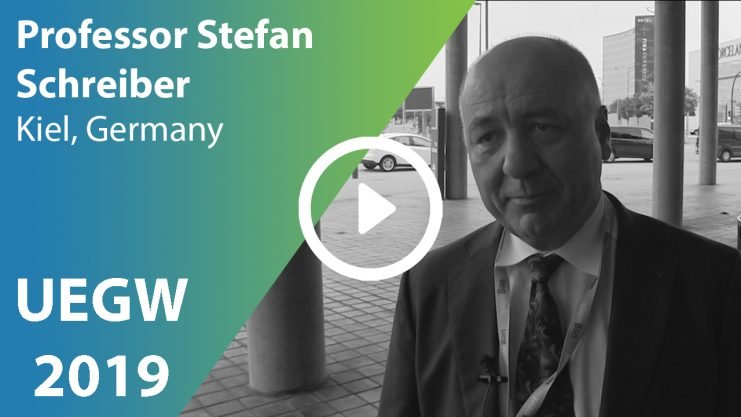Advertisment
Late-breaking abstracts: IBD highlights

A subcutaneous formulation of infliximab, known as CT-P13 SC, has been developed with a view to offer greater flexibility and convenience for patients.
Professor Stefan Schreiber (University Hospital Schleswig-Holstein, Kiel, Germany) presented results from a randomised, controlled multicentre study which showed that CT-P13 SC resulted in non-inferior drug exposure compared with the intravenous formulation (CT-P13 IV) in patients with moderate to severe active IBD, consistent with earlier preliminary data which indicates comparable efficacy and safety of CT-P13 SC and CT-P13 IV in patients with CD and RA.
Following two loading doses of CT-P13 IV two weeks apart, a total of 131 patients with CD or UC were randomised 1:1 to receive CT-P13 SC or CT-P13 IV from Week 6 onwards. The primary endpoint was pharmacokinetic and consisted of the pre-dose serum concentration (Ctrough) of infliximab at Week 22, on the hypothesis that to achieve similar exposure levels as the intravenous formulation, the subcutanous formulation must achieve higher trough levels. The ratio of geometric least square means of the Ctrough levels for the subcutaneous and intravenous formulations was 1,154%, with a 90% confidence interval of 786% to 1,694%. Since the lower boundary of the confidence limit was higher than the predefined limit of 80%, the study met its primary endpoint of non-inferiority of CT-P13 SC versus CT-P13 IV. In addition, no statistically significant differences were observed between the two formulations in the rates of clinical response and clinical remission at week 30, or with respect to mucusal healing and endoscopic response at Week 22.
Both CD and UC patients in the two treatment arms achieved very similar scores on the Short Inflammatory Bowel Disease Questionnaire (SIBDQ) at all points until Week 30. Likewise, CRP and faecal calprotectin levels decreased to similar levels after the intravenous loading doses in the two treatment arms, and comparable numbers of patients achieved faecal calprotectin levels below 250µg/ml. The safety profiles were comparable in the CT-P13 SC and CT-P13 IV arm and as expected from previous studies, with no new safety signals detected. Professor Schreiber particularly highlighted the finding that fewer patients in the CT-P13 SC arm had developed anti-drug antibodies against infliximab at Week 30 (38% versus 54% in the CT-P13 IV arm). At Week 22, 20% of patients in the intravenous arm had infliximab levels below the limit of detection (0.1µg/ml), compared with only 1.6% of patients in the subcutaneous arm. In Professor Schreiber’s opinion, sequential treatment with intravenous followed by subcutanous infliximab appears to be advantageous for managing antigenicity, although the underlying mechanism for this observation is unknown.
In another late-breaking abstract, Dr Julia Liu (University of Arkansas for Medical Sciences, Little Rock, USA) presented the results of a study carried out at five IBD centres across the US, to investigate the hypothesis that ileal microvilli length (MVL) may be a biomarker for predicting the therapeutic response to vedolizumab in CD, independent of ileal epithelial cell pyroptosis. Assessing MVL on haemotoxylin and eosin-stained biopsy specimens provides a measure of microvilli gene expression, which is known to be significantly reduced in CD patients, and is a biomarker of malabsorption.
A total of 43 adult patients diagnosed with CD and eligible for vedolizumab treatment were included in the study and underwent pre-treatment biopsies. The primary endpoint was clinical response, defined as a reduction of Harvey-Bradshaw Index (HBI) of five points or more from baseline and stratified by pre-treatment MVL, after at least six months of treatment. The plot of the probability of a clinical response by ileal MVL followed a bell-shaped curve, with MVLs of 1.35 to 1.55µm being associated with the highest response rates. Patients in this stratum had a clinical response rate of 82% to vedolizumab, compared with 44% in patients with MVLs below 1.35µm and 40% in those with MVLs above 1.55µm (p=0.036). Patients who were positive for two biomarkers, MVL range 1.35 to 1.55µm and pyroptosis level below 14 positive cells/1,000 ileal epithelial cells, had a response rate of 78% to vedolizumab, compared with 25% among those who were negative (p=0.001). Combining these two biomarkers yielded 84% sensitivity and 67% specificity. No correlation was found between ileal MVL and epithelial cell pyroptosis or baseline clinical and endoscopic disease indices.
The investigators concluded that ileal MVL is an independent predictor of clinical response to vedolizumab in CD, and that combining ileal MVL with ileal epithelial cell pyroptosis can discriminate vedolizumab responders from non-responders.





